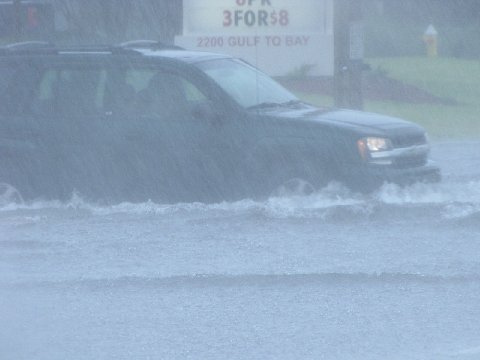A flash flood can occur in an incredibly short amount of time (hence the name “flash” flood). It is important for you to know the facts about floods. Causes of flash floods include heavy rainfall or dam/levee failure. Flash floods are the leading cause of weather related deaths in the U.S. with about 200 deaths per year (See Stats Here)
Here are some important tips that you should keep in mind should you ever be at risk of experiencing a flash flood.

“half hour of rain – flash flood,” © 2010 kthypryn (flickr username), used under a Creative Commons Attribution-license: http://creativecommons.org/licenses/by/2.0/deed.en
Be aware of weather warnings. The best way to survive a flash flood is to know ahead of time that one is coming. If you are aware and alert, you can take precautions like the ones listed below. Best to get to high ground and wait for the danger to subside.
Be aware of surroundings. Know where to find high ground. Know where waterways are and stay away from them. Flash floods usually occur at waterways due to rivers or streams overflowing.
Don’t try to cross floodwaters. They can appear shallower and calmer than they really are. It doesn’t take much depth for flood waters to take control of you or your vehicle and sweep you into the current.
Abandon your vehicle if it is stuck. The majority of flash flood deaths are vehicle related. Because flash floods usually take people by surprise, they appear harmless at first. When your vehicle is stuck, you are going to want to try and get it free. The problem is that it only takes 1 to 2 feet of flood water to sweep a vehicle away. In just a matter of minutes, you could be stuck in your vehicle as it is being swept away in the flood. Your vehicle is probably one of your most valuable assets, but it is not as valuable as your life or the lives of your family.
If you do get caught in a flood in your vehicle. Get out of the vehicle ASAP. You have a better chance of surviving outside of your vehicle. If you wait too long, the pressure differential between the inside and outside of your car will make it virtually impossible to open the door. Get out before your car is submerged to the point that the door cannot be opened. If you are already beyond that point, immediately roll down the window and climb out. If you can’t roll down the window, wait until the car starts to fill with water and then open the door. It will be easier to open when there is equal pressure inside and outside. However this takes a while and you need to be aware that you may even have to wait until you are under water for a little while. Don’t panic, and do all you can to conserve oxygen.
If you do get caught in a flood outside of a vehicle. Position your feet so that they point downstream and navigate your way over obstacles. This will prevent injury. One of the dangers is that you could be pummeled into an object that knocks you unconscious. Angling yourself feet first will allow you to brace yourself with your feet and legs to absorb the impact of contacting debris and other objects. Try to steer your way to a building or higher ground so that you can get out of the flood waters.
If you are stranded on a building or high ground. Stay where you are and wait for someone to come and rescue you. Do not try and swim for it or brave the flood in any way. Your best chance for survival is to stay put. Someone will find you and rescue you.
Be prepared for a flood evacuation with dry bags for supplies and flotation. Here is a great video from a great youtube channel called “My Disaster Blog”:




Extremely helpful! Thanks!
Glad you found it helpful!!!
Living in Arizona now. (Which has the “stupid driver law” that basically says if you drive into a wash and get stuck, you will have to pay search and rescue to come get you.)
I haven’t been in any extreme flash floods – just obnoxiously too much to drive in type floods.
Yes, I’ve been in a car that’s floating down the street…luckily we were able to float it over to a raised driveway, but still.
One thing about heavy rains in a populated area – if you wait long enough, you’ll see someone else try to drive across it…and immediately get a real great idea of whether you can make it or not….keeping in mind how your vehicle compares to theirs. (Arizona actually posts sticks with depth markers near where high flood waters are common so you can see how many feet deep it really is.)
Wow. Thanks for sharing.
[…] Flash flood A brief but powerful surge of water that flows either over a surface (‘sheet flood’) or down a normally dry stream channel (‘stream flood’). Usually it is caused by heavy convectional rainfall of short duration, and is typical of semi-arid and desert environments.(Encyclopedia.com, http://www.encyclopedia.com/topic/flash_flood.aspx). A flash flood can occur in an incredibly short amount of time (hence the name “flash” flood). It is important for you to know the facts about floods. Causes of flash floods include heavy rainfall or dam/levee failure. Flash floods are the leading cause of weather related deaths in the U.S. with about 200 deaths per year (Matt, http://www.howtosurvivestuff.com/survival-lifestyle/survive-this/how-to-survive-a-flash-flood). […]